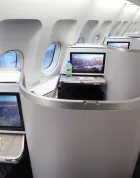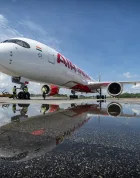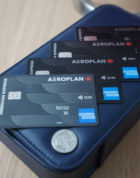As a reminder, the idea behind this series is to help intermediate-level points practitioners on their way to becoming “pros” at the game.
We’ll be looking at something I’ve dubbed the Mileage Mindset – in other words, how the pros think about each and every potential deal that comes their way. I’m also drawing upon examples of the most incredible deals we’ve ever seen, so that you get a sense of the underlying logic and an idea of what to be looking out for.
For now, we’ll continue looking at redeeming points, and next week we’ll jump into the earning side of things.
Last week, we spoke about the cornerstone of every mileage program: the award chart. But of course, it isn’t this chart alone that dictates what you can and cannot include on your award ticket.
If we think about the award chart as just the tip of the award redemption iceberg, then the vast majority of the iceberg would be the mileage program’s routing rules: the rules that govern how you can get from your origin to your destination.
Rules on stopovers and open-jaws fall under this category, as do things like Aeroplan’s maximum permitted mileage (MPM) rule, which you can read about in the Aeroplan Mini-RTW series. In theory, routing rules are supposed to constrain your journey and prevent you from booking crazy itineraries at the airlines’ expense.
Playing by the Rules
One way to look at routing rules is to ask the question: how can I maximize what I’m getting out of my miles, given the routing rules at hand?
“Maximizing” a trip means different things to different people. Maybe you want to have as many stopovers and long layovers as possible, or perhaps you’re more inclined to score as much flying time as possible in luxurious premium cabins.
On the other hand, if you’re one of the “normal” people who prefers to get as direct a routing as possible, maybe this particular article isn’t quite up your alley 😉
Current example
If you want to redeem an Aeroplan award between Montreal and Perth, Australia, the maximum permitted mileage (MPM) is 18,164 miles.
I’ve mentioned before that it’s therefore possible to book a one-way journey on Star Alliance hitting up all six inhabited continents. Here’s an amped-up version of that itinerary with a few more long layovers added (total flown mileage of 18,151):
Remember, you don’t get two stopovers unless you make it a round-trip ticket. But even as a one-way, you are able to book something like that and get to spend a day in each one of those cities, all for only 45,000 Aeroplan miles in economy or 80,000 miles in business class. That’s an incredible deal – the sort of deal that gets many of us lamenting our lack of vacation time!
When trying to piece together an itinerary to maximize long layovers, keep in mind that it’s beneficial to add cities that are as close to your existing flight path as possible. For example, adding a layover in Singapore between Bangkok and Perth doesn’t really increase your total mileage flown, since the original Bangkok–Perth flight pretty much already passes over Singapore. By adding layovers this way, you can really stretch your available MPM and nail down an insane number of layovers.
Current example
If you’re less interested in doing long layovers and more keen on getting the best bang for your buck in terms of the first class experience, you’ll want to think a little differently.
There’s only a handful of Star Alliance airlines with a first class product worth their salt: Lufthansa, ANA, Thai Airways, and arguably Asiana. Of course there’s also Singapore and Swiss, but they’ve been blocking first class from partners for a long time now.
You’ll have to do your research on which routes on which airlines offer first class. But as an example, the following Australia–Europe award is quite conducive to getting a great bang for your buck (Auckland–Paris MPM is 18,952 miles, and the below routing comes in at 18,025).
That’s nine hours in Thai first class, seven hours in ANA first class, and twelve hours in Lufthansa first class, all for just 130,000 Aeroplan miles. Even better, there’s no fuel surcharges on the Lufthansa leg since we’re originating in Hong Kong, which has blocked fuel surcharges. Originating from North America, you can probably fit in two of those first class cabins on a North America–Australia award. Three will be tough.
Notice how in the above example, we ensured that our routing remained compliant with MPM while also leveraging the fact that Hong Kong has outlawed fuel surcharges, in order to lower the overall cost of the award redemption.
That’s what the experts do best: they remain aware of all the existing “tricks” at any given time, and when they need to travel, they draw upon their knowledge at a moment’s notice in order to book things for spectacular value.
Other Routing Rules
One more example. Many points programs, like Aeroplan, follow variations of the MPM rule for dictating how you can plan a route between two cities, but not all of them. For example, the rule with Alaska Airlines Mileage Plan is that you can only book partner awards with ONE of Alaska’s partners (plus Alaska itself), and you’re not allowed to route through the same city twice.
Current example
Many of Alaska’s partners operate out of a single hub – for example, Cathay Pacific in Hong Kong, or Japan Airlines in Tokyo. This can make it tough to “maximize” your routing without passing through the hub city twice.
The trick is to take advantage of fifth-freedom flights (i.e., flights operated by a country’s airline between two other countries). For example, while Alaska’s official policy is that it isn’t allowed, I’ve known several people who have been able to ticket Vancouver to Hong Kong via New York JFK, on Cathay Pacific with Alaska miles. If you book this in first class, that’s a total of 21 hours of flight time in one of the world’s finest first class cabins, all for just 70,000 Alaska miles (and you can still add on more segments after Hong Kong).
Current example
Even though Alaska devalued their award chart with Emirates in March 2016 (making business and first class awards almost prohibitively expensive), you can still take advantage of Emirates’ fifth-freedom routes to book some damn cool routings…
Pushing the Limits
There are several great examples of unbelievable deals that were possible because routing rules weren’t being properly enforced, or in some cases, weren’t in place at all. In fact, to even call these “deals” would be doing them a disservice – a more apt description would be “beating the hell out of the system”.
I’m going to describe a few of them here. I’ll admit up front that there may well be sizeable gaps in my knowledge, so if you were one of the lucky souls who was “in” on the tricks, feel free to fill me in.
Just keep in mind that these tricks were so shockingly good that everybody who was “in the know” also knew better than to share them openly, which is why they lasted as long as they did.
Historical example
Let’s go back to Alaska Mileage Plan. Remember that rule I mentioned which prevents you from routing through the same city twice? There was apparently a way to get around it.
I’m not sure exactly how it worked – I believe that you had to respect the rule when you made your booking initially, but then you were able to call in and change your ticket, adding more segments to your ticket that would allow you to “backtrack” through the same city more than once. And since Alaska allows free changes to award tickets until 60 days out, that opened the door for some people to go wild. Let’s just say that those people got to know Dubai International Airport very intimately.
Historical example
Remember the shocker of a frequent flyer program that was Avianca LifeMiles? Perhaps the most famous example of exploiting routing rules came in the form of “LifeMiles tricks”. It was dead easy to exploit LifeMiles’s routing rules, the primary reason being that they didn’t have any.
There were quite literally no controls built into the online search engine. For example you could fly from Montreal to Mexico City via Frankfurt and you’d be charged North America–Mexico pricing, even if you flew Lufthansa First Class on both legs. It was called a “boomerang” – the route map suffices as an explanation.
Even better, if you just need a one-way to Europe, you could book the above routing and just get off the plane in Frankfurt. It was hidden-city ticketing on steroids. It’s hard to even imagine what the most dedicated of LifeMiles “tricksters” were able to get away with. And remember, all of this was in addition to LifeMiles’s geographical gaffes and mis-coded cities, as I mentioned in Part 1 on Award Charts.
(People ran hidden-city ticketing on this as well – since Guam was considered part of North America, Asia-bound travellers would book a ticket to Guam with a layover in Tokyo, and just get off the plane in Tokyo.) This made LifeMiles the ultimate “secret” in the points community for many years.
While all these examples are sadly no longer valid, they demonstrate to us how and where to look for similar deals and tricks today. Think about how many frequent flyer programs there are out there – just to illustrate, the SPG program alone has 30+ transfer partners. I have no doubt that similar loopholes still exist today, and it’s down to us to find them.
The above tricks were all discovered when, whether intentionally or not, someone tried something. Maybe the first person to make changes to their Alaska-issued Emirates ticket never meant to bend the rules, but was surprised to discover what was possible. The main point here is that as an expert in Miles & Points, you must recognize that there are always more deals to be found. As long as you keep your eyes and ears open, perhaps you’ll be the one to discover the next big thing.
I’ll leave you with a modern-day example of what I’d consider “pushing the limits” when it comes to routing rules. I don’t want to give away too much, so the below is just one potential example out of many…
Current example
As we all know, Alaska Mileage Plan allows stopovers on one-way journeys. It also doesn’t limit your routing ability, as long as you stick with one partner carrier.
So say you’re trying to use Alaska miles to book a round-trip from Singapore to Tokyo on Japan Airlines. But instead of booking it as a round-trip, what if you booked a one-way trip from Singapore to Jakarta, with a “stopover” in Tokyo instead? You could do this for just 25,000 miles in business class (intra-Asia one-way), and all you’d need is a cheap economy ticket to get you back to Singapore at the end…
Conclusion
Let’s recap the key tenets of maximizing routing rules, the “burning questions” you should be asking:
- How can I maximize the value of my miles, given my travel goals and the routing rules at hand?
- Are there routings that are officially not allowed, but can still be booked?
- Which programs have “loose” routing rules? How can I make the most of these programs?
In order to get the most out of what I’ve written here, go play around with some of the current examples I’ve laid out. We’ll carry on next week with a discussion on the Mileage Mindset as it relates to earning points. I’m quite certain that’ll be a fun one.




















